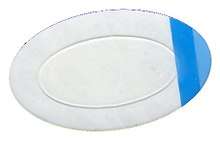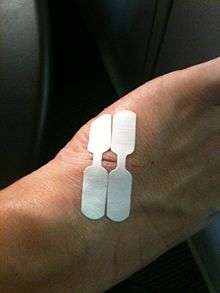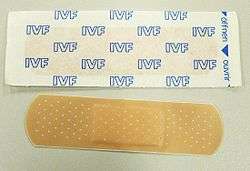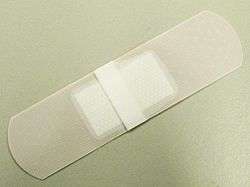Adhesive bandage
An adhesive bandage, also called a sticking plaster, medical plaster, or simply plaster in British English, is a small medical dressing used for injuries not serious enough to require a full-size bandage. They are also known by the genericized trademarks of Band-Aid (as "band-aid" or "band aid" in the US, Canada, and Australia) or Elastoplast (in the UK). It was first invented in 1901 and popularised by Oskar Troplovitz, a German Jew from Gliwice city,[1] although the idea was first contrived in 1880 by Germans Paul Carl Beiersdorf and Paul Gerson Unna, in Hamburg.[2]
Function
The adhesive bandage protects the wound and scab from friction, bacteria, damage, and dirt. Thus, the healing process of the body is less disturbed. Some of the dressings have antiseptic properties. An additional function is to hold the two cut ends of the skin together to make the healing process faster.[3]
Design
An adhesive bandage is a small, flexible sheet of material which is sticky on one side, with a smaller, non-sticky, absorbent pad stuck to the sticky side. The pad is placed against the wound, and overlapping edges of the sticky material are smoothed down so they stick to the surrounding skin. Adhesive bandages are generally packaged in a sealed, sterile bag, with a backing covering the sticky side; the backing is removed as the bandage is applied. They come in a variety of sizes and shapes.
Materials

The backing and bag are often made of coated paper, but may be made of plastic.
The adhesive sheet is usually a woven fabric, plastic (PVC, polyethylene or polyurethane), or latex strip. It may or may not be waterproof; if it is airtight, the bandage is an occlusive dressing. The adhesive is commonly an acrylate, including methacrylates and epoxy diacrylates (which are also known as vinyl resins).[4]
The absorbent pad is often made of cotton, and there is sometimes a thin, porous-polymer coating over the pad, to keep it from sticking to the wound. The pad may also be medicated with an antiseptic solution. In some bandages, the pad is made of a water-absorbing hydrogel. This is especially common in dressings used on blisters, as the gel acts as a cushion.
Many people have allergies to some of these materials, particularly latex and some adhesives.[5]
Variants

Special bandages are used by food preparation workers. These are waterproof, have strong adhesive so they are less likely to fall off, and are usually blue so that they are more clearly visible in food. Some include a metal strip detectable by machines used in food manufacturing to ensure that food is free from foreign objects.[6]
Transdermal patches are adhesive bandages with the function to distribute medication through the skin, rather than protecting a wound.[7]
Butterfly closures, also known as butterfly stitches, are generally thin adhesive strips which can be used to close small wounds. They are applied across the laceration in a manner which pulls the skin on either side of the wound together. They are not true sutures, but can often be used in addition to, or in place of real sutures for small wounds. Butterfly stitches can be advantageous in that they do not need a medical professional to be placed or removed, and are thus a common item in first aid kits.[8]
Notable brands
See also
References
- https://gliwice.eu/en/city-gliwice/famous-people-gliwice/oscar-troplowitz
- https://www.tesa.com/en/about-tesa/facts-figures/history
- "Code of Federal Regulations Title 21". April 1, 2015. Retrieved September 9, 2015.
- Daniel More, MD. "Allergy to Bandages and Adhesives". About.com Health.
- Daniel More, MD. "Allergic Reactions to Adhesive Bandages". About.com Health.
- "Blue Detectable Plasters". safetyfirstaid.co.uk. Archived from the original on 2014-09-09. Retrieved 2014-12-02.
- Segal, Marian. "Patches, Pumps and Timed Release: New Ways to Deliver Drugs". Food and Drug Administration. Archived from the original on 2007-02-10. Retrieved 2007-02-24.
- "How do I apply butterfly stitches?". www.nhs.uk.
External links



